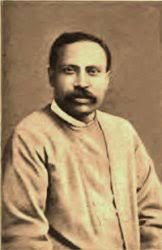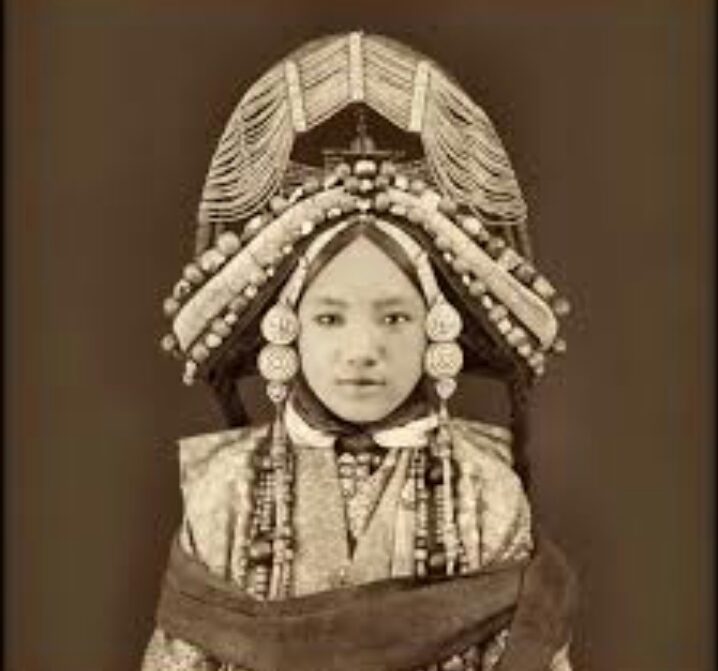[It is the year 1882. Sarat Chandra Das, the scholar spy of the British government in India, has sneaked into Tibet and is hosted by the prime minister of Panchen Lama at Tashilhunpo monastery. Here Das befriends an influential Tibetan princess, Lhacham, who invites the Bengali to go to Lhasa with her entourage. But Das falls ill on the way and is taken to Samding Gompa for treatment.]
Samding Gompa sat atop a low hill upon a bare plateau. The path to it went around a lake. Sarat’s grooms wrapped him in blankets, put a turban on his head, sunglasses to cover his inflamed eyes, and set him on a pony. Riding on it for some distance his fever-wracked body went limp, and they had to tie him to the saddle. Each breath of the icy wind lacerated his lungs. At one place he saw a flock of eagles roosting on crags and a pair of men in white clothes and turbans working on something on a stone terrace. They were cutting up human cadavers into small pieces and laying them on the stone. This funeral custom was known as jhator—the offering to the birds, the sky burial. The scene was dyed in the midnight blue of his sunglasses.
A flight of steps cut into the hillside rose to the monastery’s gate. As Sarat dragged himself up it, sudden dizziness hit his head like a sledgehammer. A porter had to be found to carry him in a basket to the top. As their sick master waited outside the gompa’s gate, one of the grooms took Lhacham’s letter inside. Two fierce Yamdo watchdogs chained to the gate post growled at the human figure swaddled in blankets and in dark sunglasses.
Amchi, the physician, had his quarters inside the maze of the monastery. Rolling a prayer wheel, the grizzled old man, who gave off a smell of snuff, examined the patient: he inspected the latter’s eyes and the tongue, asked a volley of questions about the nature of the pain, its habits, the colour and smell of shit, piss and phlegm. Medicines were administered, and lodgings arranged inside the lamasery. Two low six-by-eight-feet rooms, darkened with the greasy soot of butter lamps, were rented for four annas per day. Sarat had also to pay for Dorje Phagma’s gifts, tea and alms for eighty monks, and the ritual chanting of sutras to appease the evil demigods.
But nothing worked. Hours and days turned into an endless bog as Sarat sank into delirium. Meanwhile, following Dorje Phagma’s instruction, a reed effigy was made of him in order to deceive death. Live fish were also released into the lake. As he wallowed in fever, Sarat could vaguely sense unknown men shuffling about the room, their voices swirling around in the yak-butter air long after they’d left. His effigy, fitted with his clothes and the sunglasses, kept vigil. Someone wanted to borrow his pony to go to the fishermen’s village to buy fish, another came carrying a pill from Dorje Phagma containing Kashyap Buddha’s remains. The Thunderbolt Sow had read his fortune on a dice, a messenger announced, and had forecast that the Pundit from India wouldn’t die, but would suffer great pains. She would also come to see him soon. Strong winds blew day and night, knocking at the doors, making the wooden building creak and groan like a storm-tossed boat. It became mixed up with the relentless chanting in the next room.

Sarat lay tossing, ravaged by nightmares. Once, he saw the familiar face of a woman under the veil of a mustard-yellow sari leaning over him; she was looking at his face with tearful eyes. He opened his eyes and looked out of the tiny window to find Dorje Phagma stretched out on her back against the horizon and her protruding rows of mammaries, composed into a series of mountain ranges, squirting blue thunderbolts. Was he going to die? He thought with horror. Inside this nightmare gompa? So far away from his family and home? Sarat summoned a lama and dictated his will through the thick haze in his head. The winds carried demonic laughter and beastly wails. The noise fanned out to the distant hills and rebounded, and continued to hammer in the veins pulsing at his temple.
And then it all stopped. The chanting ceased, the silence of a sealed cave prison descended over the world. Sarat opened his eyes and saw his own effigy propped up against the wall, facing him, casting a sullen look through the blue glasses. He got up from the sweat-soaked bed and stepped out of the room, his body feeling light as a feather. A strange otherworldly light lit up a narrow courtyard before him, ashes were borne aloft in the air.
Not a soul was around. He saw rows upon rows of cells piled on all sides like a beehive, a jumble of hanging balconies and step ladders flying in all directions. He drifted along the labyrinth and came to the entrance of a low deep hall with innumerable columns. It was dark. Sarat stepped inside and brushed against a column: it began to sway. Suddenly he noticed that what he’d mistaken for columns were in fact pagras, carcasses of sheep roasted alive, hanging from their hind legs. He had entered the meat cellar of the monastery.
But the more he tried to get out, the more he lost his way, and strayed deeper into the shadowy forest of pagra, into the interior of the hall where the death cries of the animals were coiled in a spiral of mist and, in its silent centre, hung Lhacham. She was completely naked, pale as death, suspended on a steel hook that clamped into her lower jaw and went right through her cranium; and yet, surprisingly, the pupils of her eyes were moving, her cold unfeeling gaze was fixed upon his face.

Excerpted with permission from Bells of Shangri-La: Scholars, Spies, Invaders in Tibet, by Parimal Bhattacharya, Speaking Tiger Books, 2019. Rs. 450.
[Cover picture: Lhacham; All photographs courtesy: Parimal Bhattacharya]


Comments are closed.